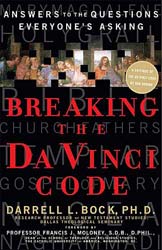|
Breaking The Da Vinci Code by Darrell L. Bock Reviewed by Tim Chaffey |
|
In my latest review of a critique of The Da Vinci Code, I chose to read a book by renowned scholar Darrell L. Bock. Dr. Bock is the Research Professor of New Testament Studies and Professor of Spiritual Development and Culture at Dallas Theological Seminary. He stated that he wrote this book as a “result of being constantly asked about issues raised by the novel The Da Vinci Code by Dan Brown.”[1] Dr. Bock has appeared on several nationally televised programs including an ABC program on this topic as well as Diane Sawyer’s program regarding Mel Gibson’s The Passion of the Christ. Of the three Da Vinci Code books we have reviewed so far (see also Cracking Da Vinci's Code and The Truth Behind The Da Vinci Code), Dr. Bock is uniquely qualified to respond to the most important issues raised in Dan Brown’s novel. Dr. Bock focused most of his attention the claims made in The Da Vinci Code concerning Jesus, Mary Magdalene, and the so-called Gnostic Gospels. In convincing fashion, he dismantled the myth that it was unnatural for a Jewish man to remain unmarried therefore Jesus had to have been married. By comparing several religious orders of the day, Dr. Bock demonstrated that is was quite normal during Jesus’ time for religious men to remain single. This claim by Brown has no historical credibility or support yet it forms the skeleton on which The Da Vinci Code is built. The record of Mary Magdalene is also set straight. She was not Jesus’ wife as Brown claimed. Instead, she was a loyal follower of Christ and occupies a unique place in all of human history in that she was the first person to see the risen Lord. As Bock decisively illustrates, Brown’s claims concerning Mary Magdalene also fall flat. Finally, in regards to the so-called Gnostic Gospels, Bock corrects Brown’s numerous false claims in this area. There were never eighty Gospels considered for canonization as Brown’s fictitious character Leigh Teabing boasts in the novel. At best, the Gnostic works found at Nag Hammadi numbered in the fifties and most of the Gnostic texts were not gospels at all as The Gnostic Society Library’s website points out. Even those who share some of his views refute his claims. Since Brown’s three main points fail so does the rest of his claims. Bock does not spend time in dealing with all of the fictitious claims concerning the Knights Templar, Opus Dei, and the Priory of Sion. He does provide a short appendix that deals with these organizations and tells the truth about them. Dr. Bock has done a wonderful job in discrediting this work of fiction and in doing so has done the church a huge favor. The book was highly readable so one does not need to be a theological scholar to appreciate it. One of its strong points was that he rarely cited the Bible to support his arguments.[2] Readers who do not believe in the Bible should be able to read this book and agree with its conclusions. Overall, I would give this a 9 out of 10. I’m a “give me the facts” kind of guy so I was hoping for a little more information on the numerous false claims made in The Da Vinci Code. For this reason alone, I preferred Richard Abanes book, The Truth Behind The Da Vinci Code. Nevertheless, Dr. Bock’s book is an excellent addition to the subject. [1] http://www.dts.edu/media/viewarticle.aspx?id=1 [2] Not that we would have a problem with anyone citing the Bible but in this case, Bock is attempting to show that Brown’s claims do not hold up against any of the evidence. Because of this approach, he is able to avoid the claim that he is using circular arguments (the Bible to prove the Bible).
(11/04/05) |
|
Rating: (9 out of 10) About the Author
|
